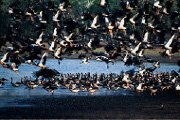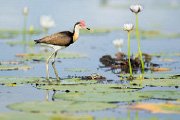Amazing facts
Kakadu is an amazing place, full of delightful surprises. Discover who owns Kakadu, how many crocs live here and how tall a termite mound can grow!
Amazing facts about Kakadu
Do you know the answer to the following questions about Kakadu? See how many you can guess correctly!
- How big is Kakadu?
- How long have Aboriginal people lived in Kakadu?
- How old is Kakadu’s rock art?
- Who owns Kakadu?
- How many crocs live at Kakadu?
- How many bird species live in Kakadu?
- How much rain does Kakadu get?
- Do Aboriginal people still live traditionally?
- How many plant species grow in Kakadu?
- How big do Kakadu’s termite mounds get?
- How tall does speargrass grow?
- When did Kakadu become a national park?
How big is Kakadu?
Kakadu is almost 20,000 square kilometres – that’s about half the size of Switzerland.
How long have Aboriginal people lived in Kakadu?
More than 65,000 years – we are the oldest living Culture on earth.
How old is Kakadu’s rock art?
Our oldest paintings are up to 20,000 years old. You can see some fascinating records of more recent events too – look out for the ‘first contact’ paintings at Nanguluwurr, showing the tall ships that first brought Europeans to our land.
Who owns Kakadu?
More than half the park is Aboriginal land, and all of Kakadu is special to its Traditional Owners. Kakadu’s Traditional Owners manage the park in partnership with Parks Australia, playing a key role in everything from Board decisions to hands-on management of weeds and feral animals.
How many crocs live at Kakadu?
We’re home to more than 10,000 crocodiles – a tenth of all the crocs in the Northern Territory! That’s one croc every two square kilometres on average … although if you look carefully at places such as Cahills Crossing and Yellow Water wetlands, you can see up to seven crocs in the one stretch of water.
How many bird species live in Kakadu?
We are home to around 280 different types of birds – around a third of all the bird species in Australia.
How much rain does Kakadu get?
Over three months every tropical summer, we get drenched by up to 1.5 metres of rain. That’s enough to blanket roughly one third of the park in flood waters, stretching out on either side of the highways as far as the eye can see. It’s a beautiful sight!
Do Aboriginal people still live traditionally?
Life has changed over recent decades, but our traditions have stayed strong. Some of us live in the towns and settlements in Kakadu, but we still spend lots of time out on our Country – hunting, fishing and caring for the land, just as our ancestors did.
How many plant species grow in Kakadu?
We are home to around 2,000 different types of plants. The plant life changes dramatically as you drive from one part of Kakadu to another. Our coast is lined with mangroves, which make way for monsoon rainforest, waterlily-covered billabongs and open woodland as you head further south.
How big do Kakadu’s termite mounds get?
Up to and over six metres tall! Look out for them along the Maguk Road and in the southern part of the park in general.
How tall does speargrass grow?
By the end of each tropical summer, the speargrass lining our roads has grown over three metres high. Then along comes Bangkerreng or ‘knock em down storm season’ – a time recognised by Aboriginal people for the big winds that blow all the speargrass flat.
When did Kakadu become a national park?
Kakadu was declared a national park in three stages, between 1979 and 1991.
Take the first step
A journey of 1000 miles begins with a single click.
Enter your email to get free trip planning advice from Kakadu rangers.





